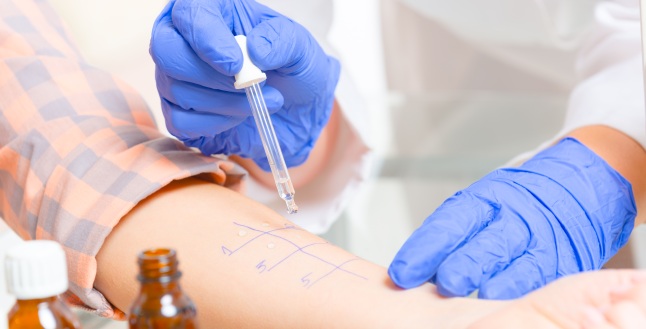Anaphylactic shock - allergic reaction that can be fatal

The main signs and symptoms are caused by a combination of several reactions installed throughout the body: 1. Signs in the skin: redness, lesions of the face or edema / bite. 2. Respiratory signs due to the difficulty of breathing, which is caused by swelling of the tissues of the throat (larynx leading to laryngospasm) and a bronchial spasm that produces wheezing like the asthma crisis. 3. Cardiac signs caused by a sudden decrease in pulse acceleration, which may be poorly felt in the wrist and sometimes irregular.
Other symptoms that may occur are: - a choking or a \. Most of the times, anaphylactic shock cases get to an emergency and, being serious cases, there is no time to waste for investigations. Examine the patient, connect to a device to monitor blood pressure, and initiate anti-allergy injectable treatment to have a faster effect. Then, if the patient is out of danger, other investigations such as skin tests - to see what is allergic and to avoid certain drugs, food and insect bites, and if unknowingly contacting one . The rapid establishment of treatment allows the regression of signs and symptoms, without too many complications.
In the event of a delay or fulminant evolution, death can be established without results in resuscitation maneuvers. In order not to misuse the correct treatment it is important to make a differential diagnosis with the other pathologies that may cause similar symptoms. These pathologies are: a severe asthma crisis that causes breathing and breathing difficulties, panic attacks are accompanied by a feeling of \. Anaphylactic salvage medication to be administered in ambulatory or at the time of arrival of the ambulance at the scene is adrenaline injected either subcutaneously or intramuscularly or intravenously, which can also be administered by the patient if it is not serious or by other trained persons. Even after relieving symptoms, treatment is needed because there is a possibility of relapse in the next few hours.
After discharge, the patient is instructed what to do if a symptom is recurring, or if he or she goes through another episode, and is advised to take antiallergic (or antihistamine) treatment that is taken at night at bedtime because it can create during the day. If it is impossible to take before bedtime, it will be administered with caution. Prevention and education are very important for patients known with multiple allergies and antecedents. These are made following an allergic investigation that allows the patient to know all the substances banned for him and avoid the occurrence of a severe allergy that can lead to anaphylactic shock. After the investigation, the patient initiates what he needs to know if he is exposed to an allergic episode of various causes and begins with the recognition of the symptoms that may occur suddenly, then with the first aid medication, which consists of a special kit available in .
To avoid the appearance of an anaphylactic shock, you must avoid important allergenic factors and, in imminent cases, should be rapidly acted upon by safe and accurate medical means to avoid the onset of shock and possible serious complications. .
Source : sfatulmedicului.ro
Views : 3080
Popular Article
- (photo) Nude becomes art.
Posted: 2018-03-17, 9815 views.
- The harmful effects of air conditioning on the skin
Posted: 2017-06-08, 8527 views.
- 3 causes of dyed hair discoloration
Posted: 2017-06-15, 8409 views.
- Why early puberty occurs in girls: symptoms, favors, diagnosis and treatment
Posted: 2017-10-24, 8253 views.
- Good or bad skin treatments in the hot season
Posted: 2017-06-07, 7981 views.
Recommendations
- (photo) Nude becomes art.
Posted: 2018-03-17, 9815 views.
- The harmful effects of air conditioning on the skin
Posted: 2017-06-08, 8527 views.
- 3 causes of dyed hair discoloration
Posted: 2017-06-15, 8409 views.
- Good or bad skin treatments in the hot season
Posted: 2017-06-07, 7981 views.
- Risks of practicing sports on hot days
Posted: 2017-06-12, 7557 views.
 4 effective ingredients in the fight against acne.
4 effective ingredients in the fight against acne. How to get rid of hiccups fast
How to get rid of hiccups fast The wheat bran diet: the secret of lost pounds as if by magic
The wheat bran diet: the secret of lost pounds as if by magic The recipe that will sweeten your soul this weekend!
The recipe that will sweeten your soul this weekend!  Is it dangerous or not to refreeze meat after thawing it?
Is it dangerous or not to refreeze meat after thawing it?  The unusual sign of diabetes indicated by saliva.
The unusual sign of diabetes indicated by saliva. What to drink to boost your immune system.
What to drink to boost your immune system. 10 foods that help you never age.
10 foods that help you never age. What actually happens in your body if you drink a cup of coffee for breakfast
What actually happens in your body if you drink a cup of coffee for breakfast 5 surprising benefits of chia seeds
5 surprising benefits of chia seeds